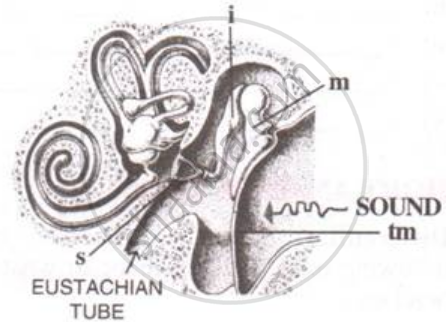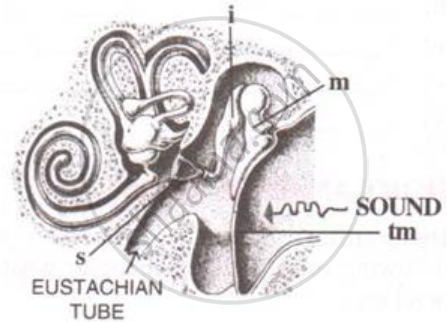Advertisements
Advertisements
प्रश्न
Name the following:
The ear ossicle attached to the tympanum.
उत्तर
Malleus (hammer)
APPEARS IN
संबंधित प्रश्न
Which part of our body helps us in maintaining the body balance?
Deafness is causal due to the rupturing of the Pinna.
Eye : Optic nerve : : Ear : ___________
Mention the exact location of the Semi-circular canals
State whether the following statements are true (T) or false (F). If false, correct them by changing any one single word in each.
Semi-circular canals are concerned with static (positional) balance.
Where is the Cochlea located? Briefly mention its function.
Where is the Utriculus located? Briefly mention its function.
The figure below is the sectional view of a part of the skull showing s sense organ:

Name the sense organ.
There are three small bones in the muddle ear – anvil, hammer and stirrup :
(a) Which of these bones is in touch with ear-drum ?
(b) Which of these bones is in touch with oval window ?
The diagram alongside represents the structure of the human ear.
(i) Write the names of the parts labelled a to g.
(ii) State briefly the functions of the parts b, d, and g.
(iii) Name the main division of the ear.
(iv) Which is the smallest bone in the human body?
(v) What is labyrinth?

Choose the correct answer.
Labyrinth is a part of ____________
The figure below is the sectional view of a part of the skull showing a sense organ:

What are the parts labeled 'm', 'i' and 's'? What do these parts constitute collectively?
The following diagram refers to the ear of a mammal.

(i) Label the parts 1 to 10 to which the guidelines point.
(ii) Which structure:
(a) converts sound waves into mechanical vibrations?
(b) Converts vibrations into nerve impulses?
(c) Responds to change in position?
(d) Transmits impulses to the brain?
(e) Equalizes atmospheric pressure and pressure in the ear.
State the Function:
Endolymph
The range of audible frequency for the human ear is
Describe the structure and function of the human ear?
Vibrating particles travel all the way from the vibrating objects to the ear.
Note the relationship between the first two words and suggest the suitable word/words for the fourth place.
Semi-circular canal : Ampulla :: Cochlea : ______.
